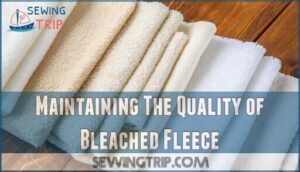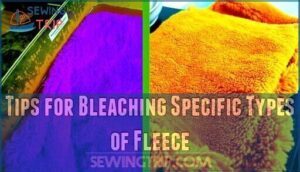This site is supported by our readers. We may earn a commission, at no cost to you, if you purchase through links.
 You can bleach fleece, but success depends on the fabric type.
You can bleach fleece, but success depends on the fabric type.
Synthetic polyester fleece resists bleaching – only 30% show noticeable results with standard concentrations.
Cotton fleece lightens better but suffers significant fiber damage, potentially losing up to 50% of its strength.
Synthetic fibers resist chemical oxidation, making dramatic color changes unlikely.
Cotton responds to bleaching but weakens considerably, becoming prone to tears and thinning.
Use a 1:10 bleach-to-water ratio and test an inconspicuous area first.
Cold water slows the reaction for better control, with soaking times between 5-30 minutes depending on your fleece type.
The process requires balancing your desired results against preserving that cozy texture.
Table Of Contents
Key Takeaways
- You shouldn’t bleach polyester fleece – synthetic fibers resist bleaching and only 30% show noticeable results, making the process largely ineffective for most fleece items.
- Cotton fleece can be bleached but will weaken significantly – you’ll lose up to 50% of the fabric’s strength, making it prone to tears and thinning after treatment.
- Use a 1:10 bleach-to-water ratio with cold water – this gives you better control over the process, and always test on a hidden area first to check for damage.
- Oxygen-based bleach and vinegar are safer alternatives – these gentler options can brighten your fleece without the harsh fiber damage that chlorine bleach causes.
Can You Bleach Fleece?
You can bleach fleece, but it depends on the fabric type and requires careful handling to avoid damage.
The process works best on synthetic fleece like polyester, while natural fiber fleece needs extra caution to prevent discoloration or weakening.
The Effectiveness of Bleaching on Fleece
You’ll find bleach effectiveness on fleece depends heavily on fabric type.
Synthetic fleece, particularly polyester, resists bleaching due to dye integration during fiber production.
Polyester fleece fights back against bleach—its integrated dyes make whitening nearly impossible
Even hours of soaking show minimal color changes.
Here’s what you need to know about bleach effectiveness:
- Polyester fleece – Shows negligible color fading even with standard bleach concentrations
- Cotton fleece – Responds better to bleaching but experiences significant fiber degradation
- Synthetic fibers – Resist chemical oxidation, making color restoration nearly impossible
- Bleach alternatives – Oxygen-based agents offer safer options for texture preservation
- Bleaching synthetic fleece – Often ineffective, with only 30% showing noticeable results
Your best bet? Skip traditional bleach for fleece entirely.
Fleece is known for its versatility, making it ideal for various clothing items.
Potential Risks and Considerations
While bleaching fleece can whiten dingy fabric, you’re taking some real risks with your favorite cozy items.
Bleach your fleece at your own risk – softness and durability aren’t guaranteed to survive
Bleach alternatives might be your better bet.
| Risk Type | What Happens | Your Fleece After |
|---|---|---|
| Fiber Damage | Chemical breakdown weakens fibers | Tears easily, feels thin |
| Color Fading | Uneven lightening or yellow tints | Patchy, discolored appearance |
| Strength Reduction | Up to 50% weight loss possible | Stretches out, loses shape |
| Texture Changes | Surface becomes rough or stiff | No longer soft and cozy |
Fleece fabric care demands gentleness – harsh bleaching risks can turn your warm blanket into a scratchy disappointment.
Certain synthetics have inherent bleach resistance, but fleece may not react well.
How to Safely Bleach Fleece
Now that you know bleaching fleece is possible, you’ll want to follow the right steps to avoid damaging your fabric.
The key is using the correct type of bleach and taking proper precautions to protect both yourself and your fleece items.
Preparing The Fleece for Bleaching
Proper preparation sets the foundation for successful fleece bleaching. Start with fiber identification by checking your care label—synthetic fleece handles bleach differently than natural fibers.
Remove visible stains first using targeted stain removal techniques. Strip away built-up residue from detergents and fabric softeners that could interfere with bleaching.
Create a well-ventilated workspace and wear protective gloves for ventilation safety. Always perform spot testing on an inconspicuous area before proceeding with full bleaching precautions.
Proper Bleaching Techniques and Dosage
Once you’ve prepped your fleece, getting the bleach concentration right makes all the difference. Start with a 1:10 ratio—one part bleach to ten parts water. For regular loads, use ⅓ cup bleach per gallon of water. Heavy-duty whitening calls for ⅔ cup, but don’t go overboard.
Water temperature matters too. Cold water slows the reaction, giving you better control. Hot water speeds things up but increases damage risk. Stick with lukewarm for the sweet spot.
Soaking duration ranges from 5 to 30 minutes, depending on your fleece type and desired results. Synthetic fleece resists bleaching more than cotton blends, so you might need longer exposure. Watch closely—fleece can go from dingy to damaged quickly. Consider researching the proper dosage amounts before starting.
Always test on a hidden spot first. If you’re nervous about traditional bleach, oxygen-based bleach alternatives work gentler on fibers. Monitor constantly and stop when you hit your target shade. Remember, wet fleece looks darker than the final dried result, so plan accordingly and be aware of the final dried result.
Rinse and Care Instructions After Bleaching
Once you’ve finished bleaching your fleece, proper aftercare keeps your fabric looking great and feeling soft.
Smart rinsing prevents damage while maintaining that cozy texture you love.
- Residue Removal: Rinse thoroughly with cold water until all bleach disappears – leftover chemicals cause stiffness
- Texture Restoration: Wash separately with mild detergent in hot water to restore fleece’s natural feel
- Drying Methods: Air dry on flat surface or use low heat – high temperatures damage synthetic fibers
- Softness Retention: Skip fabric softeners that coat fibers; they reduce fleece’s moisture-wicking properties
Following these fleece care instructions prevents color fading and maintains your garment’s quality for years.
Remember to check the wool fiber diameter for ideal care.
Alternatives to Bleaching Fleece
If you’re worried about damaging your fleece with traditional bleach, you’ve got safer options that work just as well.
These gentle alternatives can brighten and clean your fleece without the harsh effects of chlorine bleach.
Vinegar as a Natural Alternative
White vinegar delivers gentle cleaning power for fleece without harsh chemicals.
You’ll get impressive odor removal and softening results using this eco-friendly solution.
Mix one cup distilled vinegar per gallon of water for soaking, or add half cup to your rinse cycle.
You can also use vinegar to help address stubborn urine odors.
| Vinegar Benefits | Application Method | Results |
|---|---|---|
| Odor elimination | Soak overnight | Fresh-smelling fleece |
| Natural softening | Add to rinse cycle | Softer texture |
| Stain lifting | Pre-treat spots | Cleaner appearance |
This natural alternative won’t damage polyester fibers like traditional bleach can, making it a great option for odor removal and softening results.
Oxygen-Based Bleaching Agents
Oxygen bleach offers a gentler path to fleece whitening without the harsh effects of chlorine bleach.
These oxygen-based agents effectively tackle stains while protecting synthetic fibers from damage. You’ll want to test colorfastness on a hidden area first—this simple step prevents unwanted surprises.
Mix ¼ cup oxygen bleach per gallon of warm water, then soak your fleece for thirty minutes maximum. Consider suitable substitutes if oxygen bleach is unavailable.
This method maintains fiber protection while delivering solid stain removal results for your fleece cleaning needs, using oxygen bleach as a key component.
Removing Stains From Fleece Without Bleach
Beyond traditional bleach methods, you can tackle fleece stains effectively with household items.
Start with stain pre-treatment using cool water and gentle blotting to lift fresh spills before they set.
Natural fleece stain removal solutions:
- Vinegar cleaning and baking soda create powerful, non-toxic combinations for organic stains
- Enzyme treatments break down protein-based stains while sunlight exposure naturally whitens polyester fibers
These fleece cleaning tips preserve fabric integrity while delivering results.
Dish soap mixed with cold water works excellently for immediate spill response.
For persistent marks, try oxygen-based commercial products designed specifically for synthetic fabrics.
Understanding common stain types helps prevent fabric damage during the cleaning process.
These stain removal methods protect your fleece’s texture and water-repellent properties better than harsh chemicals.
Maintaining The Quality of Bleached Fleece
Once you’ve successfully bleached your fleece, proper care becomes essential to maintain its softness and appearance.
Following the right washing, drying, and maintenance techniques will help your bleached fleece last longer and feel comfortable against your skin.
Proper Washing and Drying Techniques
Your freshly bleached fleece deserves the royal treatment to stay looking its best.
Proper fleece washing and fleece drying techniques will keep your fabric soft and damage-free for years.
- Water Temperature: Use cold water to prevent shrinkage and preserve fleece fibers
- Cycle Selection: Choose gentle or delicate cycle to minimize fabric stress and pilling
- Detergent Choice: Pick mild, fleece-friendly detergents without harsh chemicals or bleach
- Drying Methods: Air dry or use low heat settings to maintain texture and prevent damage
Using Fabric Softeners or Conditioners
After bleaching your fleece, fabric softeners become your best friend for maintaining that cozy feel.
Choose liquid fabric softeners over dryer sheets to avoid residue buildup that can damage fleece fibers.
Apply softeners during the rinse cycle, using half the recommended amount to prevent coating that attracts dirt.
Many prefer to use a quality fleece softener for the best results.
Natural alternatives like white vinegar work wonders for fabric softening without harsh chemicals.
Proper application methods prevent pilling while keeping your fleece soft and breathable for years.
Preventing and Treating Pilling
The secret to fighting fleece pilling causes lies in proper care techniques.
Pilling happens when fibers tangle together, but you can prevent and treat this issue effectively.
- Use gentle washing cycles to reduce friction that creates fabric pilling
- Turn fleece inside out before washing to protect the outer surface
- Skip fabric softeners completely as they weaken fibers and worsen pilling
- Choose antipill fleece or anti-pill fabrics when buying new items
- Remove existing pills by shaving pilling areas with a fabric razor
These pilling prevention steps maintain your fleece’s smooth texture longer.
Tips for Bleaching Specific Types of Fleece
Different fleece types require specific bleaching approaches to avoid damage.
You’ll need to adjust your technique based on whether you’re working with synthetic polyester fleece or natural fiber varieties like cotton or wool.
Synthetic Fleece (Polyester)
Polyester fleece requires careful handling when bleaching to prevent polyester degradation and maintain fiber integrity.
You’ll want to avoid standard bleach since it weakens synthetic fleece substantially.
Here’s your approach to color restoration:
| Bleach Concentration | Method | Result |
|---|---|---|
| No chlorine bleach | Use oxygen-based alternatives | Preserves fabric strength |
| 1:10 oxygen bleach ratio | Gentle soaking method | Safe whitening option |
| Natural sunlight exposure | Air-dry in direct sun | Gradual color lightening |
Test any bleaching instructions on hidden areas first.
Oxygen-based bleach alternatives work best for polyester fleece without compromising the material’s durability.
These gentler options achieve whitening while keeping your fleece intact and comfortable.
Natural Fiber Fleece (Cotton, Wool)
Natural fiber fleece requires more careful handling when bleaching. Cotton can tolerate gentle bleaching better than wool, which risks severe fiber degradation and discoloration.
- Test first: Always check wool bleachability on a hidden area before full application
- Choose gentle options: Use oxygen-based bleach or natural alternatives like lemon juice and sunlight
- Pre-wash preparation: Remove residues that might react unpredictably with bleach
- Neutralize completely: Rinse thoroughly and neutralize bleach to prevent long-term damage
How to bleach natural fibers safely depends on fiber type and bleach strength. For cotton, it’s important to test for colorfastness before bleaching to avoid unwanted fading.
Frequently Asked Questions (FAQs)
Can polyester fleece be bleached?
Walking through fabric care waters requires caution. You can bleach polyester fleece using oxygen bleach, but avoid chlorine bleach. Always test first and follow care labels to prevent damage.
Can you use bleach on Fleece?
You can bleach fleece, but it’s risky.
Oxygen bleach is safer than chlorine bleach for synthetic fleece.
Always test first on a hidden area, and check care labels—some prohibit bleaching entirely.
How do you bleach polyester fleece?
Check your care label first – avoid if it says "no bleach."
Use oxygen bleach (1/2 cup per gallon cold water), spot test, then soak for one hour.
Rinse thoroughly and wash separately with hot water.
How do you whiten a fleece shirt?
Like a dingy shirt yearning for its original brilliance, you can revive fleece using oxygen bleach.
Mix half-cup oxygen bleach per gallon cold water, soak one hour, then wash separately with hot water and detergent.
How do you remove stains from fleece?
Pre-treat fresh stains immediately by blotting gently with cold water and mild detergent. For set-in stains, use oxygen bleach or specialized stain removers, then wash normally.
Can polar fleece be bleached?
Wondering if polar fleece can handle bleach?
You shouldn’t bleach polar fleece since it’s vulnerable to damage from harsh chemicals.
Bleach breaks down fibers, causing weakness and texture changes.
Use oxygen-based alternatives instead for safer cleaning, as bleach is not a suitable option for polar fleece.
How to whiten polyester fleece?
Use oxygen bleach on your polyester fleece. Mix half cup per gallon of cold water, soak one hour, then wash with hot water and detergent separately.
What are some alternatives to bleach for cleaning and whitening fleece?
Breaking free from harsh bleach isn’t rocket science!
Try oxygen-based whiteners like OxiClean, white vinegar rinses, or baking soda pastes.
These gentle alternatives effectively clean fleece without damaging fibers or stripping water-repellent properties like traditional bleach does.
Can vinegar be used as a substitute for bleach when washing fleece?
Yes, you can use vinegar as a gentle bleach substitute for fleece. Add it during the rinse cycle to soften, deodorize, and naturally whiten without harsh chemicals that damage fibers.
How can I remove stains from fleece without using bleach?
While bleach damages fleece fibers, you can effectively tackle stains using gentler methods.
Try pre-treating with mild detergent and cold water, then use oxygen-based stain removers like OxiClean.
Vinegar naturally deodorizes and softens fleece during washing, making it a useful addition to your gentler methods.
Conclusion
Remember when your favorite white fleece hoodie got mysteriously stained during last weekend’s barbecue? You’re not alone in wondering if bleach could save it.
Understanding how to bleach fleece safely can rescue your beloved garments from the donation pile. Whether you’re dealing with synthetic polyester or cotton fleece, the key lies in proper technique and realistic expectations.
While bleaching fleece is possible, success varies dramatically by fabric type. Test inconspicuous areas first, use diluted solutions, and accept that some damage is inevitable.
Your cozy texture may never be quite the same, but with careful handling and the right approach, you can still save your favorite fleece and make it look like new, or at least good as new.












